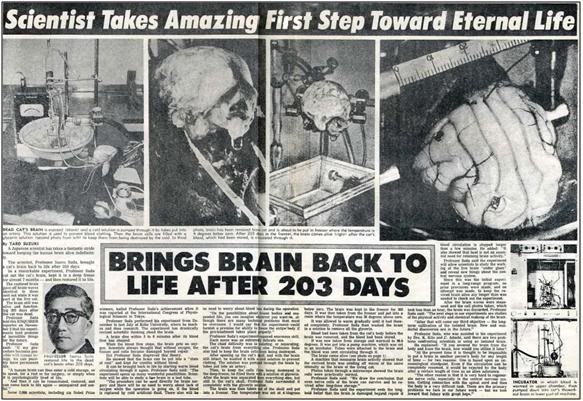By Mike Darwin
 An Unusual, but Perhaps Valuable Analogy
An Unusual, but Perhaps Valuable Analogy
This isn’t 1964, 1974, or even 1984 anymore, we aren’t in Kansas, and cryonics is not in the position it once was in. One of the reasons I was never a strong advocate of gay rights is that, long before it enjoyed the success it has, I could see that it would destroy one of the core values it was ostensibly launched to protect, namely the gay culture that had existed for centuries in the Western world. I used to tell my gay friends this at the time, and they would become enraged. Perhaps rightly so; they could see only the repression and injustice in a society that demonized homosexuality – and the self loathing, fear, and personal suffering that resulted. What they failed to reckon with is that homosexuality is a biological predilection, not a culture.[1-3] The culture that gay men “created” and inhabited prior to ~ 1990, was a product of both their biology and the attitude towards them of the culture they were embedded in. This two part dynamic generated a way of life and a culture that was exclusive, intimate, unique, and almost exclusively homosocial. While this microverse was a really bad place at its worst, it had many good features, as well.
What Shall it Profit a Man if he Gains the Whole World but Loses His Soul?
Literally without exception (no hyperbole here), I was the lone voice pointing out that being an outsider has some pretty powerful compensating advantages. One of the least appreciated and most profound of those advantages, is that if you are to survive under such conditions, you must, without exception, come to your own judgment about your own worth, the worth and the correctness of the core values of your culture and religion, and, should you decide to go on living, what kind of value system you will use to get you through life. Some gay men, confronted with the crucible of being told that everything they value and respect “rejects them, and even damns then to hell,” decide that there are no values in life beyond their own immediate gratification, advancement and prosperity. Three instructive examples of this from the last century are Truman Capote, Ray Cohn, and J. Edgar Hoover. The rest of us tried to try to make sense of it all. One very visible consequence of the effect of having to make those kinds of decisions, is that everything in life is on the table, and that includes the purpose of life, the justness of death, and the reliability of contemporary medical and scientific authority. No wonder then, that the first generation of cryonicists consisted of an unusually large number of gay men.
 Figure 1: Former ACS President Jerry White (left).
Figure 1: Former ACS President Jerry White (left).
The American Cryonics Society’s (ACS) president for many years, Jerry White, the Cryonics Institute’s one-time dynamic editor of The Immortalist, and promoter of cryonics Pat Dewey, (who was also later President of the Cryonics Society of Illinois), Carlos Mondragon, former President of Alcor, and myself (also a former President of Alcor) were all not only cryonicists, we were also publicly “out” gay men. Jerry is now in liquid nitrogen, Pat chose death in the face of AIDS, and Carlos and I will, if we are unlucky/lucky enough, get our turn pushing up bubbles in liquid nitrogen whilst awaiting rescue. If cryonics works for any of us, it will be in no small measure because we were outsiders who learned a powerful thing as small children in the hardest of ways; how to think for ourselves, independent of how society and the culture informed us were the “right and proper” ways.
 Figure 2: Former Alcor President Carlos Mondragon.
Figure 2: Former Alcor President Carlos Mondragon.
But the gay men I counted as friends and associates in my youth were unmoved by my arguments, and “Comes the revolution!” was the mantra of the 1970s and ’80s. Well, the revolution is here, and now gay men from my cohort (those still living), are groaning in agony and shrieking in pain because their culture is gone – and I do mean gone. Young gay men don’t know who Oscar Wilde was, think Judy Garland is irrelevant, and what’s worse, bring straight people into gay bars and gay special interest organizations, and even more shockingly, bring children to the latter, in no small measure because they now increasingly have children of their own.
My partner is on the Board of Directors of a gay backpacking, hiking and 4-wheel driving club. Recently, after months of brutally contentious meetings, many of the old guard members have quit the organization. Why? Because the younger members now have kids, have straight friends they want to bring along on club outings, and these new faces, from an increasingly mainstreamed generation, carry with them “baggage” about things like smoking pot, nudity at summer pool parties (and on outings to hot springs), and frequent casual sexual encounters between men during club outings which, while they take place in private, are nevertheless “apparent.” In short, the taboos and restrictions that people with children will obviously have, are now surfacing in and transforming a culture that previously had no use for them. These ‘last generation gay men’ woke up one day and found that they weren’t special anymore, and that the social norms and rules they had long left behind, were now being unexpectedly reapplied to them. Similarly, this current generation of young gay men, and those who will follow, are going to find that the price of acceptance and equality will be, in part, bleeding and dying on the battlefield, instead of writing poetry, or doing interior design, while a war rages on in someplace like Vietnam.
 Figure 3: Projection of the Alcor’s Life extension Foundation’s growth in membership and patient populations prepared by Ralph Whelan in 1993.[4]
Figure 3: Projection of the Alcor’s Life extension Foundation’s growth in membership and patient populations prepared by Ralph Whelan in 1993.[4]
And so it is with cryonics. This first wave of seriously threatening criticism now assaulting cryonics is a sign of “progress,” of sorts. Once an outsider institution or group starts to become incorporated into the culture, the culture starts to demand compliance with its norms, its rules, and its regulations. When Alcor began to experience significant growth, gain significant assets, and began to develop a professional culture based on a scientific-medical paradigm in the mid-1980s, I became reasonably confident that cryonics would be adequately prepared to deal with the challenge of cultural integration when the time came, 20 or 30 years down the line. I and others projected we’d have ~5-10K members by now (Figure 3), a reasonably well established internal culture, and a good, solid base of scientific, procedural and administrative competence to rely upon. Regrettably, that didn’t happen.
Who’s Gaming Who?
Gay people are (and always were) just about as good or bad as the population as a whole with respect to skills, intelligence, and wealth generating capacity. Where they were and are vastly “different” is in the realm of “conventional morality.” Be born gay (or realize it as a small child) and you will learn to deceive, and to do skillfully, just to stay alive. A 20 year old may have (in the past) announced, with considerable risk and heartache, that he was a homosexual, but a 12 year old (with rare exception) had no such option – it was simply unthinkable; and in most instances would have resulted in parental or societal intervention to change him as person, to in effect wipe out a critical part of his identity. The other major difference in gay men is a consequence of the fundamental structure of male sexuality, which is highly promiscuous, whether straight or gay – something that is masked and kept in check in heterosexual males by their need for women (who do not share this trait).[5, 6] In fact, the one way in which both straight and gay men are most alike, is in their appetite for sex and their desire for promiscuity – straight men just have a much harder time getting compliance from their partners in satisfying this desire.[7] Gay men are thus “sex machines,” by comparison, and this has profound social implications. It took the breakdown of conventional sexual morality in society as a whole, before gay rights could proceed. Heterosexual GeNexters now perform oral sex with each other almost as casually (though not nearly as frequently) as gay men do – and they have (partially) uncoupled sex from romance and marriage.[8-11]

Figure 4: A sampling of public print adverts from around London that demonstrate what would be considered a homoerotic sensibility in the US, and that arguably are homoerotic, by just about any reasonable any definition. Top left Rugby player Paul Sackey, in a massive ad for the sports drink Powerade, lower left, Sky TV ad, and at right, a Dolce and Gabana underwear ad that saturated the London Underground in 2009. Photos by Mike Darwin
Some cryonicists are heard to declaim passionately that, “we’re just like everybody else.” In fact, that isn’t the case at all, and once again a careful analysis of homosexuals and the gay rights movement reveals some interesting parallels, because the same remark is often used to justify ‘equal treatment’ of homosexuals. Virtually every study of the comparative psychosocial and neurobehavioral characteristics of homosexuals and heterosexuals reveals that they are not, in fact, “the same.” Far from it; and this should be obvious given that both straights and gays do very well at identifying gay men and lesbians, just from body language on silent, detail-masked video, or conversely, from listening to conversation samples with no video.[12, 13] The take home message is that increased cultural acceptance of homosexuals has come not by convincing the culture to embrace gays as being the same as straights (and thus equal), but rather the reverse – the culture has been transformed, in terms of both values and characteristics, to be compatible with homosexuality.
As one straight friend of mine in London remarked recently, “I don’t mind homosexuality being accepted, but I’m becoming increasingly concerned that it soon may be mandatory (see Figure 4).”[1] This is a consequence not just of the efforts of gay rights activists, but of a diverse array of mostly technologically driven cultural change resulting from the uncoupling of sex from reproduction (birth control and safe abortion), saturation exposure to the marketing machine that drives the mass media and generates heavy consumer spending, and removal of women into the workplace; with a concurrent negative impact on child rearing. Personally, I’m not persuaded that these changes to the culture are at all beneficial, but what they are is illustrative of what is possible, in terms of reshaping the culture radically and fundamentally, by exploiting the leverage provided from rapidly advancing technology’s destabilizing effect on the existing cultural equilibrium.
Technological Advance in Medicine is destroying a Centuries Old Medical Culture
The relevance of this to cryonics is that developments in medicine, like Donation after Cardiac Death, and the increasing use of reversible cryopreservation technologies to store human embryos, stem cells, and a growing range of other tissues, are forcing medicine to confront the inadequate and flawed criterion it uses to determine and pronounce death. Incremental, but steady advances in transplantation, and the growing sophistication and increased utilization of technologies like joint and eye lens replacement, dental implants, and radical plastic surgery, are having a similarly destabilizing and transformative effect – not just in medicine, but in the culture as a whole. The general effect of this creeping biological revolution in terms of things like cloning, assisted reproduction, stem cell therapies and molecularly engineered drugs for cancer treatment, is to corrode the whole world view that medicine runs on.
At first blush, that may seem all to the good, but it is vitally important to remember that it was that “old time 20th century world view of life and death” that kept us safe, because cryonics was seen as simply too ridiculous to be taken seriously. That word ridiculous is really important, because it is the perfect word, with just the right nuance, to describe the position of cryonics relative to medicine in the last century. While it is certainly true that the cryobiologists hated cryonics, they did so only because they felt threatened personally. To continue the gender conflict analogy, they found themselves suddenly recast as heterosexual male cross-dressers confronted with a bunch of raucous and demonstrative guys who really were gay! It wasn’t a happy experience for them (though I must confess, I enjoyed it immensely).
You don’t, you can’t, get too much exercised about anything that is simply ridiculous. In fact, it is in the very nature of being ridiculous that there is such refuge. Consider the definition of the word: “Deserving or inspiring ridicule; absurd, preposterous, or silly. See Synonyms at foolish. [From Latin r diculus, laughable.]” Thus, is it any wonder that so many gay men who could not hide their homosexuality, chose to be ridiculous as a survival mechanism?
Whatever else cryonics is, it isn’t ridiculous anymore, and while the current round of critics may not amount to a hill of beans, what they have done is shown us that the culture is responding to this paradigm shift in how it views life and death, and the limits of the possible in medicine, by using a fundamentally new and different push-back tactic. That tactic is to realize that by taking cryonics just seriously enough to leverage the coercive might of the state on us, at a time and place when we are unprepared, and unable to meet the enormous associated burden of regulation and cost, and when the state is also unprepared to absorb cryonics, they can exterminate us.

In this conclusion they are almost certainly correct.
Self Defense 101
Unmoderated list serves are an unalloyed evil. I’ve now over 20 years of experience with them, and I don’t know of any responsible person who believes otherwise. I’ve watched various high quality sites implode in anesthesia, critical care medicine, and numerous other disciplines and special interest areas.
This happens because of deep, biologically determined factors in human nature. This is not an opinion; it is a statement of fact. On any serious consideration, it is hard to believe that anyone would consider a “free press” to be a newspaper without an editor. There wouldn’t be enough paper to print it, and the ratio of vile nonsense, and plain confused ranting to anything bearing even a vague resemblance to fact, would be overwhelming. So, clearly that isn’t what the Founding Fathers had in mind when they gave a Constitutional mandate to free speech, and protection of the freedom of the press in the US.[2]
Instead, what they believed was that anyone has the right to express themselves in pretty broad terms (absent doing things like shouting fire in a crowded theatre). In practice, this means that people are free to speak their mind, verbally and in print, but they are still subject to civil laws regarding libel and slander. These used to be really important control mechanisms on “evil,” “bad,” or “destructive” speech – as I’ve often pointed out, many of Abraham Lincoln’s cases were slander cases.[14] As communities and communications media grew and consolidated, the newspapers, and later the electronic media as well, became the real resource for credible “public information.” What then happened was that the libel and slander suits migrated from the sphere of interpersonal community speech, to the sphere of journalism.

Figure 5: National Enquirer article 25 December, 1966 chronicling the work of Isamu Suda and his colleagues at Kobe University in Japan, who had just published in the prestigious journal Nature that they were able to recover EEG activity in cat brains after 203 days of frozen storage at -20oC.[15] The Enquirer flew a journalist and a cameraman to Japan in order to report this story!
As the media got sued and suffered losses, a number of things began to happen. The first was that they responded by becoming more responsible: they hired editors, and the editors hired fact checkers and quote verifiers. The idea wasn’t to really ensure the “truth” was being told, or to ensure honest reporting, rather it was to ensure just enough restraint, the bare minimum in fact, to avoid getting sued, or at least to reduce the incidence of litigation to a tolerable level. The second response was a consequence of the first, and that’s that there was a “split” in the media. Some papers just continued as broadsheets, packed with lies and enough truths to keep them useful – the National Enquirer is the best example of this. The Enquirer had a policy never to run misleading or phony news stories about health or biomedicine – and as a consequence, they were for years, one of the most reliable sources of information about cutting edge developments in both healthcare and biomedical research (Figure 5). Tabloid papers such as the Enquirer got away with outright fictions such as “Elizabeth Taylor and Michael Jackson are signed up for cryopreservation,” and even a fair number of calculatedly malicious lies. But they did so only at the price of “the loss of journalistic credibility.” This is not an idle ideal. This is a big deal, because basically what that means is that people regard most of what these papers print as “entertainment” – fiction based on real peoples’ lives. This is tolerated by all concerned, mostly because it is mutually beneficial.
Liz and Michael, and Brittany, and every other celebrity, want the attention, much more than they want the truth. And if the tabloids step over the line, they will usually retract and apologize, if their “victim” howls too much. It’s a well choreographed dance. However, every once in awhile, they run a libelous story that crosses the line, and do so about someone who is not dancing the Minuet with them. Saying that comedienne and actress Carol Burnett was an alcoholic, is the classic example. Stupidly, the Enquirer refused to retract and apologize for that story, and Burnett subsequently sued them costing them so much money they were almost bankrupted.
By now, hopefully, you’ve come to see at that at no point is there truly ‘consequence free’ speech, or speech that has no regulation. Speech is, (or more properly was) in fact, heavily regulated at all (public) levels, it just isn’t apparent.
It took a lot of effort and money, before the advent of the Internet, to communicate in writing, or by broadcast, with the masses. A ‘fanzine’ might have a few hundred subscribers, but it could never reach millions. Small publications like Cryonics magazine and The Immortalist did nick artwork, and excerpt quotes of such length that larger media would have been unable to get away with, simply because they did not reach a large audience. Similarly, much relaxed standards of accountability were present on such small endeavors of publication and exercises of free speech, and that was, by and large rational, and to the good.
 Then, along came the Internet, and all those centuries of largely invisible control were wiped away. Now it is possible for a single individual to broadcast with all the credibility, and all the attention getting and credibility enhancing production values of the New York Times or CBS News – and to reach many fold more people. Still more importantly, it is easily possible to selectively target the people they wish to reach in ways no newspaper editor or media mogul in the previous centuries, ever dreamed possible. That’s all wonderful, except that it has (inevitably) happened absent those critically important restraints and protections that were formerly in place – many of which were intrinsic to the high cost and labor intensive nature of mass print publication, or the infrastructure and licensing required for the broadcast media. That change can, will, and has unarguably resulted in great evil (as well as great good). It is, for instance, now perfectly possible to all but destroy someone’s professional (and personal) reputation and employment prospects, without any risk of repercussions – and there isn’t a damn thing they can do about it.
Then, along came the Internet, and all those centuries of largely invisible control were wiped away. Now it is possible for a single individual to broadcast with all the credibility, and all the attention getting and credibility enhancing production values of the New York Times or CBS News – and to reach many fold more people. Still more importantly, it is easily possible to selectively target the people they wish to reach in ways no newspaper editor or media mogul in the previous centuries, ever dreamed possible. That’s all wonderful, except that it has (inevitably) happened absent those critically important restraints and protections that were formerly in place – many of which were intrinsic to the high cost and labor intensive nature of mass print publication, or the infrastructure and licensing required for the broadcast media. That change can, will, and has unarguably resulted in great evil (as well as great good). It is, for instance, now perfectly possible to all but destroy someone’s professional (and personal) reputation and employment prospects, without any risk of repercussions – and there isn’t a damn thing they can do about it.
This was not something envisioned by the Founding Fathers. The idea of speech and writing being widely disseminated, completely disconnected from any accountability, was not even a technological possibility until the closing decades of the 20th century. Even the anonymous pamphleteer required a collaborator in the form of a printer, and as the scale of dissemination increased, the amount of infrastructure, resources, and public visibility increased as well. This made anonymity virtually impossible, because without the collaboration of ‘big media’ – and that didn’t happen unless the story was both true and worth the risk of publishing (i.e., Watergate) – it didn’t get disseminated. That control is missing today.
The notion that in the age of the Internet, the first “no load” global megaphone for truly free speech, that a tiny list serve within the cryonics community has an obligation to be “a free for all” is not only ridiculous, it is self destructive. We do not owe either our critics or our enemies a ‘guaranteed access’ bully pulpit at our expense. The closest analogy I can come up with would be to set up a venue in your front yard, and invite people to picket there and call you a child molester, a murderer, a psychopath, or any other wicked thing that they fancy. We don’t need to create a venue for them to do that, let alone to cater it with refreshments, and resting benches. The US Constitution gives such people the right to do that in plenty of public spaces, including on an Internet so vast and so capacious, it almost exceeds human appreciation. Unarguably hateful and crazy people can even show up at your child’s funeral, and say they’re glad he is dead, and that he “died defending faggots, and is burning in hell.” Such speech is protected here in the US, but we are not required to invite those who use it as their weapon to the graveside – nor into our patient care facilities. And every time we do so, we lend them credibility, because why else on earth would we give franchise to such people, when they can do the same damn thing on the sidewalk across the street from us?
This proposition that we cryonicists must create some “hallowed place for free speech” for our critics, let alone for our enemies, is bizarre beyond reckoning.
Finally, the only thing I find more offensive about this attitude than the direct harm it causes cryonics, is the implication that some cryonicists actually believe that the things these people are saying are, or might be, true. They aren’t. And anyone who invites someone into their venue to shout vile lies and insults at their neighbors (let alone at themselves), is crazy, stupid, or both.
This article is available as a PDF at: http://cryoeuro.eu:8080/pages/viewpageattachments.action?pageId=1441801&highlight=We_Aren%27t_In_Kansas_Anymore_Chronosophere_Darwin.pdf#Chronosphere+Posts-attachment-We_Aren%27t_In_Kansas_Anymore_Chronosophere_Darwin.pdf
References
1. Lippa R, Tan, FD.: Does culture moderate the relationship between sexual orientation and gender-related personality traits? Cross-Cultural Research 2001, 35:65-87.
2. Lippa R: Finger lengths, 2D:4D ratios, and their relation to gender-related traits and the Big Five. Biological Psychology 2006, 71:116-121.
3. McFadden D, Loehlin, JC., Breedlove, SM., Lippa, R.A., Manning, JT, Rahman, Q.: A reanalysis of five studies on sexual orientation and the relative length of the index and ring fingers (the 2D:4D ratio). Archives of Sexual Behavior 2005, 34:341-356.
4. Whelan R: Suspension pricing and the cost of patient care. Cryonics 1993, 14(10):9-26.
5. Lippa RA: The relation between sex drive and sexual attraction to men and women: A cross-national study of heterosexual, bisexual, and homosexual men and women. . Archives of Sexual Behavior 2007, 36:209-222.
6. Lippa R: Is high sex drive associated with increased sexual attraction to both sexes? It depends on whether you are male or female. Psychological Science 2006, 17:46-52.
7. Lippa R: Sex differences and sexual orientation differences in personality: Findings from the BBC Internet survey. Archives of Sexual Behavior 2008, 37:173-187.
8. Brady S, Halpern-Felsher, BL.: Adolescents’ reported consequences of having oral sex versus vaginal sex. . Pediatrics 2007, 19(2):229-236.
9. Halpern-Felsher B, Cornell, JL, Kropp, RY, Tschann, JM., Apr;. Oral versus vaginal sex among adolescents: perceptions, attitudes, and behavior. . Pediatrics 2005, 115(4):845-851.
10. Gates G, Sonenstein, FL.: Heterosexual genital sexual activity among adolescent males: 1988 and 1995. Fam Plann Perspect 2000, 32():(6):295-297, 304.
11. Lindberg L, Jones, R, Santelli, JS.: Noncoital sexual activities among adolescents. J Adolesc Health 2008, 43(3):231-238.
12. Lippa R: Sex-typing and the perception of body outlines. . Journal of Personality 1983, 51:661-683.
13. Lippa R: Sex differences in sex drive, sociosexuality, and height across 53 nations: Testing evolutionary and social structural theories. Archives of Sexual Behavior 2009, 38(631-651).
14. Steiner M: An Honest Calling: The Law Practice of Abraham Lincoln. DeKalb: Northern IllinoisUniversity Press; 2006.
15. Suda I, Kito, K, Adachi, C.: Viability of long term frozen cat brain in vitro. . Nature 1966, 212:167.
[1] British TV and popular culture is saturated with homosexuality, and much the advertising and public art, is frankly homoerotic.
[2] Few Americans know this, but there is no such protection in the UK, or most of the rest of the world, for that matter.

I think you are completely offbase with your ideas about why gay rights and gay awareness has become such a dominant theme in media and entertainment. There is one main reason. MONEY. Money caused gay rights and ‘love of all things Gay’ to become a focus of the pseudo-left. Money. Cui bono? Or since we about talking about the hypersexual gay community, cui bone. This trend can be blamed on the forces that brought about the civil rights movement and affirmative action and even traced back to the formation of the federal union that we now call the USA. The same forces are in play here. One phrase embodies the forces in play here: Divide et Impera. Divide and Conquer.
It is all about the class warfare waged on the working class by the forces that constitute Capital. Labor vs Capital once again. And Capital’s Divide et Impera strategy, as laid out in the writing of the primary “founding plutocrat” James Madison, aka The Father of the Constitution, means that over the decades the forces of Capital have passed to the top the idea that diversity and inclusion is good. Good for them, that is. The more diverse and inclusive society is, the more Capital benefits. Madison laid out the Divide et Impera strategy in his writings, see e.g., Federalist Paper 10. The more inclusion and diversity, the more factions. The more factions, the less united is Labor. The less united is Labor, the more profit to Capital. Cui Bono? Thus Capital benefits from diversity. See e.g., Dr Putnam’s BOWLING ALONE research. Thus, over the decades, from the elite universities, the incubator for Capital’s propaganda, came the diversity propaganda regime. Which led to mass immigration of ‘diversity,’ the multiculti propaganda regime, affirmative action, brown vs the board of education etc. And of course gay rights.
All in the interests of factionalization of the electorate, of the state, of the nation, of the workplace, of the neighborhoods. The more divided each of the building blocks of society, the more Capital profits.
It’s not a conspiracy. It’s an ecosystem.
See also Dr Woody Holton’s writings ( google ‘excess of democracy,’ madison, constitution etc). And also Dr Jerry Fresia’s online book TOWARD AN AMERICAN REVOLUTION.
I’m going to leave your post up,briefly, and then trash it. What an incoherent bunch of nonsense. — Mike Darwin
ah yes, very heretical. Are you offended? Do some of the ideas just bounce off your head? Dr Holton mentioned the same phenomenon regarding how some people took his book. Now you know how many ordinary people feel when they read about cryonics–offended and not understanding it. Many of the ideas presented above are counter to the ideological substrate laid down in your head by the culture. And others simply have no basis in your substrate. Same thing for cryonics and the general population.
No, I’m not offended personally, only generally, at the ludicrousness of these positions. And yes, that is how many feel about cryonics; but that doesn’t make cryonics wrong, and the wacky ideas of Dr. Holton, right. Nor are such comments on-point here. Who gets to decide that? I do, for the time being. Mostly my decision on what to keep or delete will have less to do with my personal tastes or opinions, and more to do with whether they are are on topic, comprehensible and not malicious. — Mike Darwin
a thought: if tomorrow morning everyone starts saying that the sun is square, I will say that it is round. Because it is. That does not mean I hate square suns or that I want to put them in zyklon B gas chambers. It just means that the sun is round, not square.
once again we see how you require ideological adherence to your ideals, mike. Do your actions belie your words?
“What an incoherent bunch of nonsense.”
I couldn’t agree more.
…and ironically enough, his post is essentially of enactment of the very kind of unaccountable free speech that was the whole point of your article, Mike.
People can spout off their own inane bullshit and get it *seen* by more eyeballs than ever before in history. Sadly, there are a good deal of willing tabulae rasae out there who are all too eager to soak it in (and act on it).
The more factions, the less united is Labor
Labor benefits from being in competition with each other, not from being “united.”
(Don’t reject me for being “heretical,” unperson. :P )
you wrote : “Labor benefits from being in competition with each other, not from being “united.””
Oh, suuure they do. They have to work harder for less money. Say, I know how I can benefit YOU. Give me 50 percent of your next paycheck. You will have to work harder to live and pay your food and rent. You can thank me now.
I’m a little bit confused how stealing 50 percent of my next paycheck is in any way analogous to the situation.
But, I’m thinking it’s probably about time to quit wasting mine.
Invidious distinctions between individuals based on wealth shouldn’t matter from cryonicists’ perspectives. The richest man in the world can slip on a patch of ice and die from traumatic brain injury, just like the poorest. Steve Jobs’s fortune can’t cure his cancer and other illnesses. And Japan’s wealthiest people realize now that their money didn’t buy them as much safety and security as they thought.
The rich are the natural enemy of Labor. Always see them as such, just as you always see a rattlesnake as a mortal danger to you if you get close to it.
Your comparison makes no sense, unless you advocate shooting rich people on sight, cutting off their heads with shovels or running them over with cars. Rattlesnakes don’t seek out humans as prey. They feed on rodents and other small animals they can swallow, and they therefore have a useful job in the ecosystem. They just bite bigger animals out self-defense.
Similarly, capitalists have the useful job of directing scarce resources towards their most productive uses, a fact which doesn’t communicate well for some reason. For example, people blame the rise of commodities’ prices on “speculators,” as it these mysterious operators just showed up on the scene to take advantage of shortages; when in fact speculators help to find the prices for commodities every day to try to clear the market, even if the prices for a commodity trend downwards. Nobody gives speculators the credit when we can get good deals on the commodities we want, but we should.
If the masses understood what capitalists really do, I’ve tried to argue that the ones attracted to cryonics and radical life extension would receive less criticism. We have a scarcity of people in any era with the ability to coordinate resources and labor to create new wealth we wouldn’t have otherwise, and we would all benefit by keeping these individuals in the life business for as long as possible.
I think I’m getting a picture of what Unperson wants, and I don’t like it. Basically, he wants cryonicists to be middle class, church going people with utterly pedestrian characters and interests. They must not be rich, nor poor, nor gay, nor other than missionary-position heterosexuals, with exactly 2.56 children. All rich people should be…? I don’t know, but I don’t think I’d like that answer, either. This kind of position is what I call “exclusionary elitism.” In this case, it’s even more disgusting than usual, because those to be elevated to the status of the elite don’t even exist in reality, they are a fantasy, just as surely was the Proletariat.
I’m an elitist too, but an “inclusionary elitist” I think there are all kinds of elites right now, and that that is, by and large, a good thing. There are several dictionary definitions for “elite” and I’m using this one, here: “more talented, privileged, or highly trained than others.” You can add onto that “…in cryonics, music, physics…” ad infinitum. We need more elites like that, not fewer. Unperson is a one-idea guy, and in that sense he is a virtual clone of the Soviet autocrats he criticizes. They had a one-idea ideology that was about as workable as Unperson’s. The interesting thing about Russia, per se (as opposed to the rest of the Soviet bloc) is that while those at the top were definitely better off than “the masses,” it was all rather sad and tawdry, compared to the usual autocracy. The homogeneity of wealth distribution was surprising and the people at the top, while materially better off, were still complete captives to the system. You didn’t see any of them fleeing to France or the Banana Republics, with billions of stolen dollars. That’s because there weren’t any such billions. Most of the capital, what little there was, was pumped into various large-scale versions of small time get rich quick schemes, that can be seen rusting and crumbling away all over Russia.
In that sense the Soviet system was “relatively moral,” in that they believed their own nutty ideology, and worked very hard to practice it. The terrible truth of the Soviet era was that it reflected a fundamental inability to think small. Continuing to the the present, the Russian mindset is surprisingly inorganic and plan-oriented. Russia today, or Russia in 2008, is notable for the LACK of highly productive small job shops, that characterizes much of the West (and which is dying here, too). If I need some elegantly crafted bit of technology, I can usually search the web (or in olden times, the phone book) and find countless fabricators in little industrial park-strip malls and garages, who will be able to make what I need. That is missing from Russia – partly as a legacy of communism, and partly because of Russian culture and philosophy. By contrast, in ostensibly still communist China, you find myriad small businesses that can make or fabricate just about any molecule, metal part, or electronic device you can imagine. The difference is stunning, and is viscerally palpable within 24 hours of being in country.
A parting example of good and bad to the Russian psyche. I visited a lab there where a fellow had a newly manufactured Russian blood pump. He turned it on and this incredible racket issued from it. As he increased the rpms, the noise got worse and worse, until we were shouting at each other over the din. When he shut it down I said, “You don’t seriously propose to use that thing, do you?” He was aghast. “It pumped blood perfectly well!” Yes, in fact it did, but its engineering failed to take into account that surgeons and staff in an operating room need to TALK to each other, and they need to HEAR monitors and alarms, and the anesthesiologist needs to be able to hear heart and breath sounds. Later, when I visited the most elite center for cardiovascular surgery in all of Russia, I saw that they were using Western blood pumps, and that they had been using Western blood pumps (principally Sarns & Cobe-Stockert) for decades. So, I asked why they didn’t use Russian made blood pumps. All I got was an indignant snort as a reply. Now, lest you think I am Russia-bashing, consider this counterpoint. One of the ISS space station modules behaved a lot like that Russian blood pump. It made a horrible racket. Ultimately, major and costly replacement was needed. The Russian boosters and spacecraft that now exclusively supply the ISS have similar features, and a well worthwhile and absolutely hair-raising read is Dragonfly: An Epic Adventure of Survival in Outer Space by Bryan Burrough. It perfectly captures Russian engineering philosophy in action. But, once you read that book, you will realize that the Russians did it, they did it, and they are still doing it, and they were the first of our species to step off this rocky-crust clad ball of magma and set foot to path for the stars. What an accomplishment! And no one can ever take that from them. Sometimes raw desire, and a big idea coupled with a fundamentally right philosophical goal, trumps even the finest capitalist engineering. — Mike Darwin
you wrote:
“Similarly, capitalists have the useful job of directing scarce resources towards their most productive uses…”
This is what happens when you take Heinlein too seriously. Modern society is not some little well oiled, benevolent moon colony where our great heroes, the capitalist entrepreneurs, are working hard for all our benefit. Modern American society is an almost out of control playground for those at the top, just as it was designed to be by our founding aristocrats. America from its very beginning was a slave colony for white slaves. And it still is that in some ways. They are the predators and we are their prey.
Yes, modern technology has been a beneficial side effect of this predacious environment, and that tech may someday revive us and give us immortality. Let us hope so.
But do not confuse this american ecosystem for something you read in some fiction book.
What we have here is an ecosystem, one where Labor is increasingly at the mercy of a predacious and rapacious Capital, just as it was in the 1600s when a huge percentage of people who lived on the atlantic coast of north america were white slaves brought here by force by Capital, where many of them were worked to death.
All same same….
a fact which doesn’t communicate well for some reason. For example, people blame the rise of commodities’ prices on “speculators,” as it these mysterious operators just showed up on the scene to take advantage of shortages; when in fact speculators help to find the prices for commodities every day to try to clear the market, even if the prices for a commodity trend downwards. Nobody gives speculators the credit when we can get good deals on the commodities we want, but we should.
If the masses understood what capitalists really do, I’ve tried to argue that the ones attracted to cryonics and radical life extension would receive less criticism. We have a scarcity of people in any era with the ability to coordinate resources and labor to create new wealth we wouldn’t have otherwise, and we would all benefit by keeping these individuals in the life business for as long as possible.
darwin wrote: “I think I’m getting a picture of what Unperson wants, and I don’t like it. Basically, he wants cryonicists to be middle class, church going people with utterly pedestrian characters and interests. They must not be rich, nor poor, nor gay, nor other than missionary-position heterosexuals, with exactly 2.56 children. ”
Laughable. I am an atheist, and the place I would most like to live is san francisco. Mike, you must have inherited money, because you have turned into a reactionary. And darn near a little old blue haired one…..or is it blue nosed?
At any rate you are well versed in the talking points of Capital Propaganda….
I didn’t say what you were, I said what you wanted. And that was based on what you said. Read you own stuff and see for yourself! –Mike Darwin